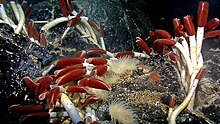巨型管虫
巨型管虫(学名:Riftia pachyptila)是西伯加虫科下的一种生物[1]。它生活在太平洋一英里以下的海底热泉附近,可以忍受富含硫化氢、水温在2至30摄氏度之间的海水。其长度可达2.4米(7英尺10英寸),直径约4厘米(1.6英寸)[2]。不同于生长速度极为缓慢的羽织虫属物种Lamellibrachia luymesi(170至250年间只能生长2米)[3],巨型管虫生长速度极快,两年内就可以长1.5米(4英尺11英寸)[4]。
| 巨型管虫 | |
|---|---|

| |
| 科学分类 | |
| 界: | 动物界 Animalia |
| 门: | 环节动物门 Annelida |
| 纲: | 多毛纲 Polychaeta |
| 目: | 缨鳃虫目 Sabellida |
| 科: | 西伯加虫科 Siboglinidae |
| 属: | 巨型管虫属 Riftia |
| 种: | 巨型管虫 R. pachyptila
|
| 二名法 | |
| Riftia pachyptila M. L. Jones, 1981
| |
发现
编辑巨型管虫发现于1977年由地质学家杰克·科利斯乘坐阿尔文号深潜器前往科隆群岛热点探勘时所发现[5]。巨型管虫的发现完全是个意外,当时的研究队伍只是为了研究当地的海底热泉,因此也没有生物学家进驻。这次探勘还在海底热泉附近发现了很多其他新物种。
由于阿尔文号深潜器搭载了机械手臂,因此也采收了许多生物的样本,包括了双壳纲、多毛纲、大型螃蟹以及约长 2 米的巨型管虫个体[6][7]。
在这之后于中洋脊附近的海底热泉也陆续发现了许多海洋生物,尽管热泉附近的温度可达 350 °C – 380 °C[8][9]。
生命史
编辑巨型管虫刚孵化时为于远洋带可自行游动不仰赖共生的担轮幼虫,在发展为后担轮幼虫后转为行固着生活,并开始仰赖共生细菌提供营养[10][11]。巨型管虫体内的共生菌并未出现于管虫的配子之中,而是在管虫孵化后,透过类似感染的形式借由皮肤自周遭环境吸收而得到。刚出生的巨型管虫具有完整的消化系统,包括口、前段肠、中段肠、后段肠及肛门。在共生菌于中段肠建立群落后,中段肠会膨胀并形成营养体,而其他部分的消化系统则会退化。在成年巨型管虫的体内,几乎看不到有原本消化系统器官的残留[12]。
身体结构
编辑若将巨型管虫去掉外部由几丁质组成的长管,其身体构造有别与传统西伯加虫科的前体部、中体部、后体部三分形式[13]。
巨型管虫身体的第一部分被称为鳃羽(Branchial Plume),主要负责提供营养给栖息于营养体内的共生细菌。其红色来自于其中由至多144个血球素链组成的血红素。这些血红素最大的特征在于能够携带并运送硫化氢及氧气,而大部分物种的血红素并无此能力[14][15]。如果巨型管虫受到来自外界的刺激,它们会将鳃羽缩回至管中,并利用壳盖将自己封闭于管内[16]。
巨型管虫身体的第二部分称为被套(vestimentum),由带状的肌肉所组成,带有两翼并在末端有两个生殖孔[17][18]。膨大的背血管结构(功能类似于心脏)就位于被套之内[19]。
巨型管虫身体的第三部分称为躯干部(trunk),包含了体壁、生殖腺以及体腔;躯干部也是管虫营养体的所在位置,营养体为海绵状的组织,储存了能提供管虫营养的硫氧化细菌与硫颗粒[20][21]。由于成年巨型管虫的嘴、消化系统与肛门均已退化,它们所需的营养均必须由这些互利共生的细菌提供[22]。细菌在营养体中所进行的化能合成,最早是由科里·卡瓦纳发现[22]。
巨型管虫鳃羽中的血红素具有携带并运送H2S及O2的能力,而体内的共生菌则能透过微血管获得这些化学物质以进行化能合成[23]。在化能合成的过程中,线粒体酵素硫氰酸酶会催化硫代硫酸盐S2O32-的歧化反应,生成S及亚硫酸盐SO32-[24][25]。
硝酸盐与亚硝酸盐具有毒性,但是氮却是生物合成的重要元素。位于巨型管虫营养体内的化能合成细菌能将硝酸盐转化为铵离子,由细菌合成氨基酸并释放给巨型管虫。为了能将硝酸盐运输给细菌,巨型管虫的血管内具有极高浓度的硝酸盐,甚至为周遭海水硝酸盐浓度的 100 倍。为何巨型管虫能够浓缩并承受如此高浓度的硝酸盐,至今仍然未知[15]。
巨型管虫身体的第四部分称为后体部(opistosome),将个体固着于管内并用来储存细菌化能合成后所产生的废物[26]。
参考文献
编辑- ^ Ruppert, E.; Fox, R.; Barnes, R. . Invertebrate Zoology: A functional Evolutionary Approach 7th. Belmont: Thomson Learning. 2007. ISBN 0-03-025982-7.
- ^ Bright, M.; Lallier, F. H. The biology of vestimentiferan tubeworms (PDF). Oceanography and Marine Biology: An Annual Review (Taylor & Francis). 2010, 48: 213–266 [2013-10-30]. doi:10.1201/ebk1439821169-c4. (原始内容 (PDF)存档于2013-10-31).
- ^ Tube Worms In Deep Sea Discovered To Have Record Long Life Spans. ScienceDaily. [2018-05-19]. (原始内容存档于2019-08-12).
- ^ Lutz, R. A.; Shank, T. M.; Fornari, D. J.; Haymon, R. M.; Lilley, M. D.; Von Damm, K. L.; Desbruyeres, D. Rapid growth at deep-sea vents. Nature. 1994, 371 (6499): 663. doi:10.1038/371663a0.
- ^ Giant Tube Worm: Riftia pachyptila. Smithsonian National Museum of Natural History. [25 Oct 2018]. (原始内容存档于2018-10-24).
- ^ Childress JJ. Biology and chemistry of a deep-sea hydrothermal vent on the Galapagos Rift; the Rose Garden in 1985. Introduction. Deep Sea Research Part A. Oceanographic Research Papers. October 1988, 35 (10–11): 1677–1680. Bibcode:1988DSRA...35.1677C. doi:10.1016/0198-0149(88)90043-X (英语).
- ^ Lutz R. The biology of deep-sea vents and seeps: Alvin's magical mystery tour. Oceanus. 1991-01-01, 34 (4): 75–83 [2020-03-11]. ISSN 0029-8182. (原始内容存档于2019-12-22).
- ^ Exploring the deep ocean floor: Hot springs and strange creatures. (原始内容存档于2021-02-26).
- ^ Koschinsky A, Garbe-Schönberg D, Sander S, Schmidt K, Gennerich HH, Strauss H. Hydrothermal venting at pressure-temperature conditions above the critical point of seawater, 5°S on the Mid-Atlantic Ridge. Geology. 2008, 36 (8): 615. Bibcode:2008Geo....36..615K. ISSN 0091-7613. doi:10.1130/g24726a.1.
- ^ Bright M. Riftia pachyptila. [2015-03-19]. (原始内容存档于2015-04-02).
- ^ Adams DK, Arellano SM, Govenar B. Larval dispersal: Vent life in the ocean column (PDF). Oceanography. Mar 2012 [2020-03-12]. (原始内容存档 (PDF)于2015-04-02).
- ^ Jones ML, Gardiner SL. On the early development of the vestimentiferan tube worm Ridgeia sp. and Observations on the Nervous System and Trophosome of Ridgeia sp. and Riftia pachyptila (PDF). Biol Bull. Oct 1989, 177 (2): 254–276 [2020-03-12]. JSTOR 1541941. doi:10.2307/1541941. (原始内容 (PDF)存档于2015-09-23).
- ^ De Beer G. The Pogonophora. Nature. November 1955, 176 (4488): 888. Bibcode:1955Natur.176..888D. ISSN 0028-0836. doi:10.1038/176888a0.
- ^ Zal F, Lallier FH, Green BN, Vinogradov SN, Toulmond A. The multi-hemoglobin system of the hydrothermal vent tube worm Riftia pachyptila. II. Complete polypeptide chain composition investigated by maximum entropy analysis of mass spectra. The Journal of Biological Chemistry. April 1996, 271 (15): 8875–81. PMID 8621529. doi:10.1074/jbc.271.15.8875.
- ^ 15.0 15.1 Hahlbeck E, Pospesel MA, Zal F, Childress JJ, Felbeck H. Proposed nitrate binding by hemoglobin in Riftia pachyptila (Free full text). Deep-Sea Research. July 2005, 52 (10): 1885–1895. ISSN 0967-0637. doi:10.1016/j.dsr.2004.12.011.[永久失效链接]
- ^ Monaco A, Prouzet P. Marine Ecosystems: Diversity and Functions. John Wiley & Sons. 2015-10-02. ISBN 978-1-119-23246-9.
- ^ Desbruyères D, Segonzac M. Handbook of Deep-sea Hydrothermal Vent Fauna. Editions Quae. 1997. ISBN 978-2-905434-78-4.
- ^ Gibson RN, Atkinson RJ, Gordon JD. Oceanography and Marine Biology: An Annual Review. CRC Press. 2010-05-12. ISBN 978-1-4398-5925-4.
- ^ Bartolomaeus T, Purschke G. Morphology, Molecules, Evolution and Phylogeny in Polychaeta and Related Taxa. Dordrecht: Springer Science & Business Media. 2006-03-30. ISBN 978-1-4020-3240-0.
- ^ Hydrothermal vents Terza parte. www.biologiamarina.eu. [2019-12-10]. (原始内容存档于2021-02-28).
- ^ Stewart FJ, Cavanaugh CM. Overmann J , 编. Symbiosis of thioautotrophic bacteria with Riftia pachyptila. Progress in Molecular and Subcellular Biology (Springer-Verlag). 2006, 41: 197–225. ISBN 978-3-540-28210-5. PMID 16623395. doi:10.1007/3-540-28221-1_10.
- ^ 22.0 22.1 Cavanaugh CM, Gardiner SL, Jones ML, Jannasch HW, Waterbury JB. Prokaryotic Cells in the Hydrothermal Vent Tube Worm Riftia pachyptila Jones: Possible Chemoautotrophic Symbionts. Science. July 1981, 213 (4505): 340–2. Bibcode:1981Sci...213..340C. PMID 17819907. doi:10.1126/science.213.4505.340.
- ^ Childress J, Fisher CR. The biology of hydrothermal vent animals: physiology, biochemistry, and autotrophic symbioses. Oceanography and Marine Biology: An Annual Review. 1992.
- ^ Corbera J. La vida que brolla a la foscor: les fumaroles hidrotermals submarines. Atzavara, L'. 2017-04-21, 27: 39–53 [2020-03-23]. ISSN 2339-9791. (原始内容存档于2021-03-09).
- ^ Simon V, Purcarea C, Sun K, Joseph J, Frebourg G, Lechaire JP, Gaill F, Hervé G. The enzymes involved in synthesis and utilization of carbamylphosphate in the deep-sea tube worm Riftia pachyptila. Marine Biology. 2000-01-18, 136 (1): 115–127. ISSN 0025-3162. doi:10.1007/s002270050014.
- ^ Riftia pachyptila - Wikipedia - Symbiotic relationship between chemosynthetic bacteria and riftia tube worms. [2019-12-10]. (原始内容存档于2019-12-10) (美国英语).
外部链接
编辑- Privett, B. Riftia pachyptila. Animal Diversity Web. 2001 [February 25, 2008]. (原始内容存档于2008-07-25).
- Giant Tube Worm page at the Smithsonian (页面存档备份,存于互联网档案馆)
- Podcast on Giant Tube Worm at the Encyclopedia of Life